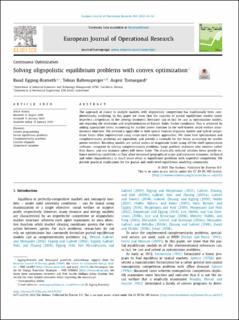| dc.contributor.author | Egging-Bratseth, Ruud | |
| dc.contributor.author | Baltensperger, Tobias | |
| dc.contributor.author | Tomasgard, Asgeir | |
| dc.date.accessioned | 2020-08-26T07:16:48Z | |
| dc.date.available | 2020-08-26T07:16:48Z | |
| dc.date.created | 2020-01-31T14:34:52Z | |
| dc.date.issued | 2020 | |
| dc.identifier.citation | European Journal of Operational Research. 2020, 284 (1), 44-52. | en_US |
| dc.identifier.issn | 0377-2217 | |
| dc.identifier.uri | https://hdl.handle.net/11250/2674024 | |
| dc.description.abstract | The approach of choice to analyze markets with oligopolistic competition has traditionally been complementarity modeling. In this paper we show that the majority of partial equilibrium models under imperfect competition in the (energy-)economic literature can in fact be cast as optimization models, not requiring the derivation and implementation of Karush-Kuhn-Tucker conditions. This is achieved by adding appropriate terms accounting for market power exertion to the well-known social welfare maximization objective. The method is applicable to both spatial Cournot oligopoly models and hybrid competition forms often implemented using conjectural variation approaches. We show how optimization and complementarity problems are equivalent, and provide a rationale for the terms accounting for market power exertion. Resulting models are solved orders of magnitude faster using off-the-shelf optimization software, compared to solving complementarity problems. Large problem instances take minutes rather than hours, and one instance solves 640 times faster. The drastically reduced solution times greatly enhance modeling capabilities as they allow increased geographical scope and represent economic, technical and other characteristics in much more detail in equilibrium problems with imperfect competition. We present practical implications for the partial and multi-level equilibrium modeling community. | en_US |
| dc.language.iso | eng | en_US |
| dc.publisher | Elsevier | en_US |
| dc.rights | Attribution-NonCommercial-NoDerivatives 4.0 Internasjonal | * |
| dc.rights.uri | http://creativecommons.org/licenses/by-nc-nd/4.0/deed.no | * |
| dc.title | Solving oligopolistic equilibrium problems with convex optimization | en_US |
| dc.type | Peer reviewed | en_US |
| dc.type | Journal article | en_US |
| dc.description.version | publishedVersion | en_US |
| dc.source.pagenumber | 44-52 | en_US |
| dc.source.volume | 284 | en_US |
| dc.source.journal | European Journal of Operational Research | en_US |
| dc.source.issue | 1 | en_US |
| dc.identifier.doi | 10.1016/j.ejor.2020.01.025 | |
| dc.identifier.cristin | 1788445 | |
| dc.relation.project | Norges forskningsråd: 209697 | en_US |
| dc.relation.project | Norges forskningsråd: 296205 | en_US |
| dc.description.localcode | This article is available under the Creative Commons CC-BY-NC-ND license and permits non-commercial use of the work as published, without adaptation or alteration provided the work is fully attributed. | en_US |
| cristin.ispublished | true | |
| cristin.fulltext | original | |
| cristin.qualitycode | 2 | |

